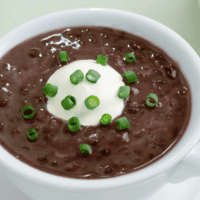Hey There! Some links on this page are affiliate links, which means that as an Amazon Associate, I may earn a small commission at no extra cost to you. I greatly appreciate your support! Learn more on my Affiliate Disclosure page.
Making your Homemade Caesar Salad Dressing is not only simple but also incredibly rewarding. With fresh ingredients and no preservatives, you’ll get a burst of flavor that’s far superior to store-bought versions.
In this guide, Chef Mark Sandoval will demystify the process and explain everything you need to know to create a delicious Caesar dressing, from the essential ingredients and tools to step-by-step instructions. You’ll be surprised at how simple it is!
Why You Will Love This Recipe

This homemade Caesar salad dressing recipe has many benefits that will make it a favorite in your kitchen. Here are a few key reasons:
| Reason | Description |
|---|---|
| Fresh, Flavorful Ingredients | Packed with fresh ingredients that you can adjust to suit your taste. |
| Healthier Option | Free from preservatives and artificial additives, making it healthier. |
| Easy to Make | Simple to prepare with common kitchen tools. |
| Versatile Use | Enjoy it in various dishes beyond just Caesar salad. |
Ingredients You’ll Need

To make the perfect Caesar salad dressing, you’ll need a mix of flavorful ingredients. Here’s a table listing all the ingredients with brief descriptions to help you understand their roles.
| Ingredient | Description |
|---|---|
| Capers | Adds a tangy, briny flavor; finely minced for even distribution. |
| Dijon mustard | Provides a tangy, sharp flavor and helps emulsify the dressing. |
| Tabasco | It adds a bit of heat; use it according to your taste preference. |
| Worcestershire sauce | Adds depth of flavor with a savory, umami taste. |
| Red wine vinegar | Adds acidity and brightness to balance the flavors. |
| Lemon juice | Freshly squeezed for acidity and a bright citrus flavor. |
| Parmigiano Reggiano | Adds a rich, nutty flavor; freshly grated for the best texture. |
| Anchovy fillets | Adds a savory, umami flavor; finely minced for even mixing. |
| Garlic | Adds a pungent, aromatic flavor; finely minced. |
| Egg yolks | Helps emulsify and thicken the dressing. |
| Blended oil | A mix of 75% Canola and 25% Extra virgin olive oil for a balanced flavor. |
| Anchovy oil (optional) | Enhances the anchovy flavor; use sparingly if desired. |
Kitchen Tools You’ll Need

Now, let’s talk about the tools you’ll need. Having the right tools makes the preparation process smooth and efficient. Below is a table of the necessary kitchen tools and their uses.
| Tool | Description |
|---|---|
| Lemon Juicer | Extracts juice from lemons efficiently. |
| Cheese Grater | Grates Parmigiano Reggiano finely for the dressing. |
| Whisk | Mixes and emulsifies the ingredients smoothly. |
| Cutting board | Provides a safe and stable surface for mincing ingredients. |
| Chef Knife | Essential for mincing capers, anchovies, and garlic. |
| Mixing bowl | Holds all the ingredients while you mix them. |
| Speed pour | Controls the flow of oil for a steady stream while emulsifying. |
| Kitchen towel | Keeps your workspace clean and can be used to secure the mixing bowl. |
Step-By-Step Caesar Dressing Instructions – VIDEO
Creating your own Caesar salad dressing is straightforward if you follow these steps.
1) Prep the Ingredients:
- Begin by mincing the capers, anchovy fillets, and garlic.
- Grate the Parmigiano Reggiano using the cheese grater, and juice the lemon with the lemon juicer.
2) Mix the Base:
- Combine the minced capers, Dijon mustard, Tabasco, Worcestershire sauce, red wine vinegar, lemon juice, anchovy fillets, and minced garlic in a mixing bowl.
3) Add the Egg Yolks:
- Add the egg yolks to the mixture and whisk until well combined.
- The egg yolks will help thicken the dressing and make it creamy.
4) Incorporate the Oil:
- Slowly pour in the blended oil while whisking continuously.
- This process, called emulsification, will help combine the oil with the other ingredients to form a smooth dressing.
5) Add Cheese and Season:
- Stir in the grated Parmigiano Reggiano.
- Taste the dressing and adjust the seasoning with additional Tabasco, Worcestershire sauce, or lemon juice if needed.
6) Optional Step:
- If you prefer a stronger anchovy flavor, add some anchovy oil at this stage.
- Whisk again to combine.
7) Final Touches:
- Whisk the dressing until it reaches a smooth, creamy consistency.
- Make sure all the ingredients are well incorporated.
8) Serve:
- Your Homemade Caesar Salad Dressing is ready to be used.
- Drizzle it over your Caesar salad or store it in an airtight container in the refrigerator for up to a week.
Tips, Tricks, and Storage Options

Making the perfect Caesar salad dressing is easy with these additional tips and tricks.
| Tip/Trick | Description |
|---|---|
| Room Temperature Ingredients | Ensure all ingredients are at room temperature before mixing to help with emulsification. |
| Adjust to Taste | Adjust the amount of garlic, anchovies, and mustard to suit your taste preference. |
| Proper Storage | Store the dressing in an airtight container for up to one week in the refrigerator. |
| Recombine Before Use | Shake or whisk before each use to recombine the ingredients. |
Serving Suggestions and Pairings

This versatile dressing can enhance many dishes beyond a classic Caesar salad.
| Serving Suggestion | Description |
|---|---|
| Classic Caesar Salad | Toss with romaine lettuce, croutons, and additional grated Parmigiano Reggiano. |
| Grilled Chicken or Fish | Drizzle over grilled meats for an extra burst of flavor. |
| Vegetable Dip | Use as a dip for fresh vegetables. |
| Sandwich Spread | Spread on sandwiches for added taste. |
Conclusion

Making your own Caesar salad dressing at home is not just fun and rewarding, but also a chance to get creative. With fresh ingredients and no preservatives, you’ll enjoy a healthier and tastier dressing.
Try making this Homemade Caesar Salad Dressing, and let us know how it turned out! Share your photos and experiences on social media using #HomemadeCaesarDressing. Don’t forget to subscribe to our blog for more delicious recipes and cooking tips!
Thank you for reading! Be sure to check back soon for more informative and exciting articles.
Happy cooking!
FAQs – Frequently Asked Questions

Can I use a different type of mustard?
You can use whole-grain or yellow mustard, but the flavor will be slightly different. Whole-grain mustard will add a bit of texture, while yellow mustard is milder.
What can I substitute for anchovies if I don’t like them?
You can substitute capers for anchovies or omit them. However, omitting anchovies will alter the traditional flavor.
How long does the homemade dressing last?
The dressing can be stored in an airtight container in the refrigerator for up to one week. Whisk or shake it before each use.
Can I use pre-grated cheese?
Freshly grated Parmigiano Reggiano is recommended for the best texture and flavor. However, pre-grated cheese can be used if you’re in a pinch.
What is the best way to store the dressing?
Store the dressing in an airtight container in the refrigerator. Shake or whisk it before each use to recombine the ingredients.
Is there a vegetarian version of this dressing?
Yes, you can omit the anchovies and use a vegetarian Worcestershire sauce. This will maintain the dressing’s flavor without using any animal products.
Can I use olive oil instead of blended oil?
You can use extra virgin olive oil, but the flavor may be more intense. Blended oil provides a more neutral taste that some may prefer.
How do I make the dressing thicker?
Adding more grated Parmigiano Reggiano or an additional egg yolk can help thicken the dressing. Whisk thoroughly to combine the ingredients.
Can I add other herbs or spices to the dressing?
Feel free to experiment with herbs like parsley or spices like black pepper. Adding different herbs and spices can create a unique flavor profile.
Hey There! Some links on this page are affiliate links, which means that as an Amazon Associate, I may earn a small commission at no extra cost to you. I greatly appreciate your support! Learn more on my Affiliate Disclosure page.




























1 Response
[…] Caesar Dressing […]